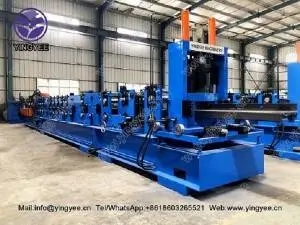
The Advancements and Importance of ERW Steel Square Pipe Making Machines
In the realm of modern manufacturing, the production of steel pipes plays an essential role across various industries, including construction, infrastructure, and automotive sectors. Among the different methods for producing steel pipes, Electric Resistance Welded (ERW) steel square pipe making machines stand out for their efficiency, precision, and versatility. This article explores the workings, advantages, and significance of ERW steel square pipe making machines in today's industrial landscape.
Understanding ERW Technology
ERW technology utilizes electrical resistance to generate heat and weld the edges of steel strips together. This process involves feeding a flat steel strip through a series of rollers that progressively shape it into a square or rectangular pipe. As the edges come together, a high-frequency electrical current is applied, causing the metal to heat up and bond without the need for additional filler materials. The end result is a sturdy, uniform square pipe that meets various specifications and quality standards.
Machine Components and Operation
An ERW steel square pipe making machine comprises several key components, including a decoiler, leveler, shear, forming station, welding station, and cut-off machine. The process begins with the decoiler, which unwinds the steel strip for feeding into the system. The leveler ensures that the material is flat and free from any defects before moving to the forming stations, where rollers shape the strip into a square cross-section.
The welding station is the heart of the operation, where the edges of the formed pipe are welded together using high-frequency currents. This sophisticated technology provides a strong and durable seam, crucial for the pipe's structural integrity. Once the welding is completed, the cut-off machine trims the finished pipes to the specified lengths, readying them for further processing or direct shipment.
Benefits of ERW Steel Square Pipe Making Machines

The use of ERW machines offers numerous advantages over traditional pipe manufacturing methods. Firstly, the efficiency of the ERW process significantly reduces production times. The continuous formation and welding of the strip into square pipes minimize delays, making it possible to produce large quantities within shorter timeframes.
Additionally, ERW machines provide remarkable precision. The automated nature of modern machines ensures consistent quality, reducing material wastage and defects. This precision is vital for applications requiring high-performance standards, such as in structural engineering and industrial applications.
Cost-effectiveness is another compelling reason for the popularity of ERW steel square pipe making machines. With reduced labor costs and improved operational efficiencies, manufacturers can achieve better profit margins while providing competitive pricing to customers. Furthermore, the energy-efficient nature of the ERW process contributes to lower production costs, making it an economically viable option for manufacturers.
Environmental Considerations
In an era where sustainability is paramount, the eco-friendly aspects of ERW steel square pipe making are noteworthy. The efficiency of the process leads to less energy consumption and lower carbon emissions compared to traditional manufacturing methods. Many modern ERW machines are designed with features that optimize energy use and reduce waste, aligning with industry standards for environmental responsibility.
Conclusion
ERW steel square pipe making machines represent a significant advancement in the manufacturing sector, offering a blend of efficiency, precision, and cost-effectiveness. As industries continue to evolve and demand for durable steel pipes increases, the role of ERW technology will undoubtedly become more prominent. These machines not only streamline production processes but also contribute to sustainable manufacturing practices. As the global market expands, the importance of ERW steel square pipe making machines will remain pivotal in ensuring that manufacturers can meet the demands of modern infrastructure and construction needs.